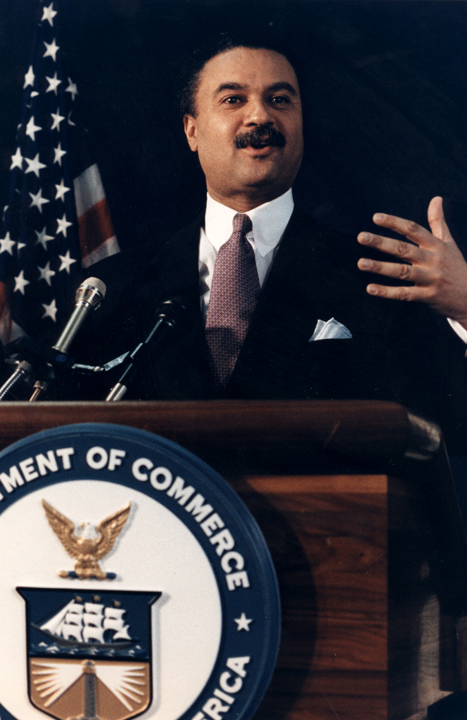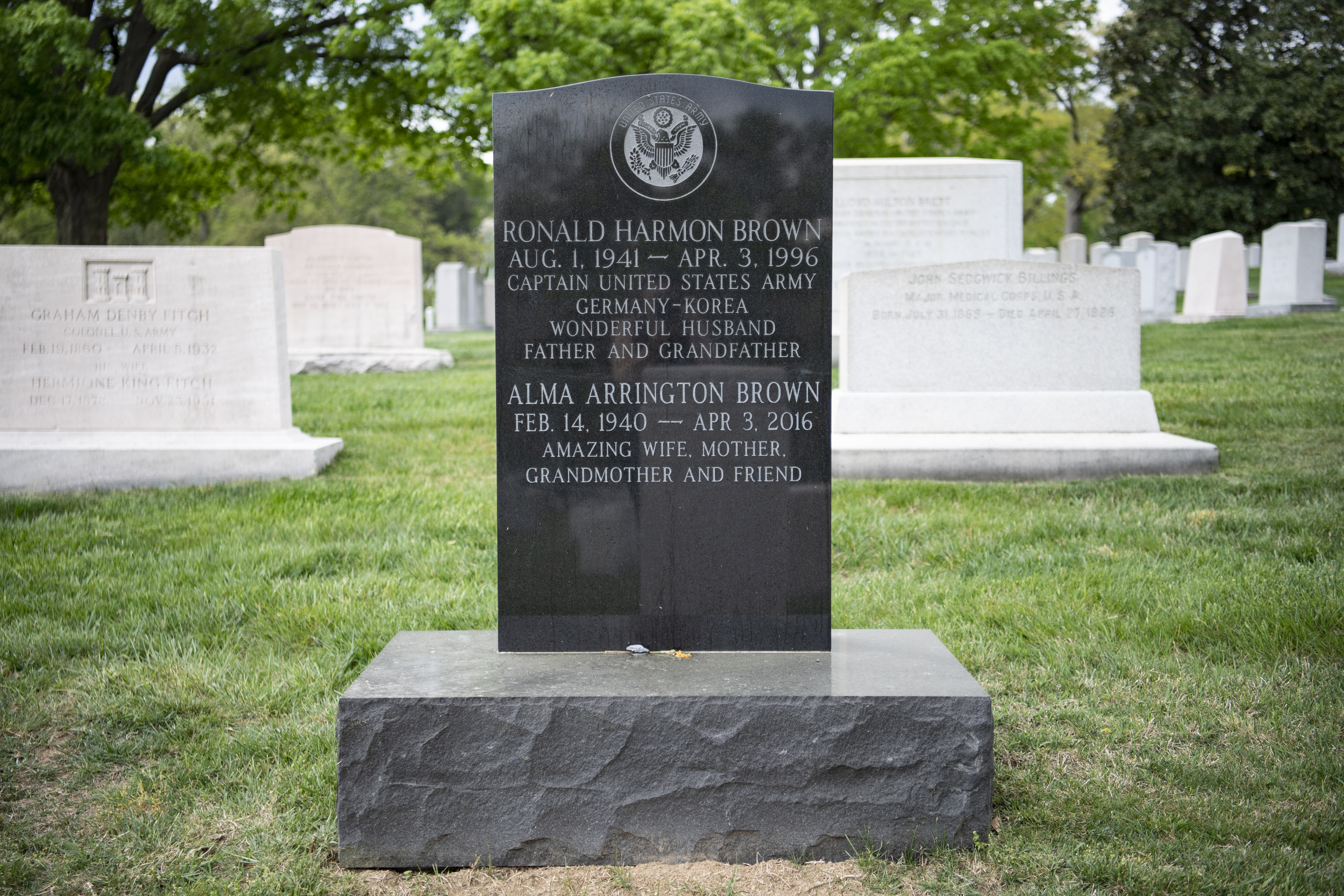1. Overview
Ronald Harmon Brown (August 1, 1941 - April 3, 1996) was a prominent American politician and a trailblazer in United States governance. He served as the 30th United States Secretary of Commerce during the first term of President Bill Clinton, and prior to that, he was the chairman of the Democratic National Committee (DNC). Brown made history as the first African American to hold both of these significant positions. His impactful career, marked by efforts to expand American business interests globally, was cut short when he died in a plane crash in Croatia along with 34 other people while on an official trade mission. His life and work are remembered for his contributions to democratic development and social justice, despite facing various controversies during his public service.
2. Early Life and Education
Ronald H. Brown's early life and educational journey laid the foundation for his distinguished career in public service and politics.
2.1. Childhood and Formative Years
Born in Washington, D.C., Ronald Brown was raised in Harlem, New York City, within a middle-class family. He was a member of Jack and Jill of America, an African-American social and philanthropic organization. Brown attended Hunter College Elementary School and Rhodes Preparatory School. His father managed the Theresa Hotel in Harlem, where Brown and his family resided. His closest friend during these years, John R. Nailor, who was one of the few other black students at Rhodes Prep, moved into the penthouse of the hotel. As a child, Brown gained early public exposure by appearing in an advertisement for Pepsi-Cola, which was notably one of the first advertisements specifically aimed at the African-American community.
2.2. Higher Education and Military Service
Brown continued his education at Middlebury College, where he achieved a significant milestone by becoming the first African-American member of the collegiate fraternity, Sigma Phi Epsilon. Upon graduating from Middlebury in 1962, he was commissioned as a 2nd Lieutenant of Armor in the United States Army through the ROTC program. In the same year, he married Alma Arrington. Brown completed tours of duty in Germany and California, and was temporarily deployed to South Korea. He left the United States Army in 1967 with the rank of Captain. Following his military service, Brown pursued a legal career, enrolling at St. John's University School of Law, where he earned his degree in 1970.
3. Early Career and Political Rise
After completing his military and legal education, Ronald H. Brown embarked on a professional path that quickly led him into the realm of public service and eventually, the highest echelons of the Democratic Party.
3.1. Entry into Public Service
Brown joined the National Urban League, a leading organization dedicated to economic equality in the United States, immediately after his military service. By 1976, his dedication and abilities were recognized with a promotion to Deputy Executive Director for Programs and Governmental Affairs of the National Urban League. In 1979, he resigned from this role to take on a significant position as a deputy campaign manager for Senator Edward M. Kennedy, who was seeking the Democratic Party's presidential nomination.
3.2. Legal and Lobbying Career
In 1981, Brown was recruited by the prominent Washington, D.C., law firm Patton Boggs, where he served as both a lawyer and a lobbyist. During this period, he became involved in controversial lobbying activities, notably representing the "brutal" Duvalier regime, which was then in power in Haiti. Over a span of four years, Brown earned 630.00 K USD for his efforts, which included helping to persuade the U.S. Administration to continue providing aid to the government led by dictator Jean-Claude Duvalier. Despite facing criticism for representing such a client, Brown maintained his commitment to the Duvaliers. In May 1988, Jesse Jackson appointed Brown to lead his convention team at the Democratic National Convention in Atlanta. By June of that year, Brown was effectively managing Jackson's presidential campaign, demonstrating his growing influence within the Democratic Party.
4. Leadership in the Democratic Party
Ronald H. Brown's leadership within the Democratic Party marked a pivotal period, culminating in his historic appointment to a top national political position.
4.1. Chairman of the Democratic National Committee
In 1982, Brown was appointed deputy chairman of the Democratic National Committee (DNC). His dedication and strategic acumen led to his election as the chairman of the DNC on February 10, 1989, making him the first African American to be chosen to lead a major U.S. political party. In this role, he played an integral part in the successful organization and execution of the 1992 Democratic National Convention. His leadership was also crucial to Bill Clinton's successful 1992 presidential campaign, helping to guide the party to victory.

5. Secretary of Commerce
Following his successful tenure as DNC chairman, Ronald H. Brown transitioned into a key role within the new administration.
5.1. Tenure and Trade Missions
In 1993, President Clinton appointed Brown as the 30th United States Secretary of Commerce. President Clinton's administration prioritized bolstering the American economy over traditional diplomacy, a goal that Brown effectively delivered upon. As Secretary of Commerce, Brown led numerous high-profile trade missions, bringing together entrepreneurs, business leaders, and financiers to expand American business interests globally. These missions spanned a diverse range of countries, including South Africa, Mexico, Saudi Arabia, Jordan, Israel, the West Bank, Gaza, Egypt, Russia, Brazil, Argentina, Chile, China, Hong Kong, Ireland, India, and Senegal. He was leading one such trade mission en route to Croatia when the tragic plane crash occurred that claimed his life. During his tenure, Brown was also involved in the Commerce Department trade mission controversy.
6. Controversies and Criticisms
Throughout his public life and career, Ronald H. Brown faced several criticisms and controversies, drawing scrutiny over financial and ethical issues.
6.1. Financial Allegations
One notable financial accusation against Brown emerged in 1993, alleging that he accepted 700.00 K USD from Vietnamese businessman Nguyen Van Hao. This payment was purportedly made in exchange for Brown's influence in lifting the Vietnam embargo. Additionally, his earlier lobbying activities on behalf of the Haitian government under the Duvalier regime, for which he earned 630.00 K USD, also attracted criticism for representing a brutal dictatorship. In 1996, prior to his final trade mission, Brown was implicated in a scheme to sell seats on the plane used for the mission. These funds were reportedly raised for Bill Clinton's reelection campaign, leading to further questions about ethical conduct in political fundraising.
6.2. Other Ethical Issues
Brown was also involved in the "Nannygate" scandal, where he admitted to failing to pay taxes for an undocumented household employee. This admission led to widespread public disapproval, with approximately 40 percent of Americans demanding his resignation at the time. Despite public pressure, Brown did not resign from his position.
7. Death
Ronald H. Brown's life ended abruptly and tragically in a plane crash, which subsequently became the subject of extensive investigation and various theories.
7.1. Plane Crash and Investigation
On April 3, 1996, while on an official trade mission, a U.S. Air Force CT-43 aircraft, a modified Boeing 737, carrying Brown and 34 other individuals, including The New York Times Frankfurt Bureau chief Nathaniel C. Nash, crashed into a mountainside. The incident occurred as the plane was on approach to Dubrovnik Airport in Croatia. The Air Force officially attributed the crash to pilot error and a poorly designed landing approach. However, the circumstances of Brown's death, particularly because he was under investigation by an independent counsel for political corruption, fueled widespread speculation about a government cover-up and various conspiracy theories. Of specific concern was a recent trip Brown had made to Vietnam on behalf of the Clinton Administration, during which he carried an offer for normalizing relations between the United States and its former communist adversary.

Concerns about suspicious circumstances surrounding Brown's death were raised by prominent African-American leaders, including Kweisi Mfume, who was then head of the NAACP, and Rep. Maxine Waters (D-CA), the chairwoman of the Congressional Black Caucus. They wrote to federal officials requesting more data. In response to allegations of homicide, an official from the Armed Forces Institute of Pathology acknowledged that doctors were initially puzzled by a circular wound observed on the top of Brown's head when his remains were recovered from the crash scene. However, after consulting with other experts and conducting extensive X-ray examinations, forensic pathologists definitively ruled out any cause beyond a blunt-force injury to the head.
7.2. Burial
Ronald H. Brown was laid to rest at Arlington National Cemetery, a military cemetery in Arlington, Virginia.

8. Legacy and Honors
Ronald H. Brown's enduring impact has been recognized through numerous posthumous honors and memorials across various sectors, reflecting his significant contributions to American politics and public service.
8.1. Posthumous Recognition and Memorials
On April 5, 1996, just two days after his death, President Bill Clinton and First Lady Hillary Rodham Clinton planted a white dogwood tree on a hill on the South Lawn of the White House in memory of Brown and the other victims of the plane crash. On January 8, 2001, twelve days before George W. Bush took office, Brown was posthumously awarded the Presidential Citizens Medal by President Clinton, with his widow, Alma Brown, accepting the honor. President Clinton also established the Ron Brown Award for corporate leadership and responsibility, an award that is privately funded and administered by The Conference Board. The U.S. Department of Commerce continues to present the annual Ronald H. Brown American Innovator Award in his honor.
Numerous academic scholarships and programs have been established to commemorate Brown's legacy. St. John's University School of Law, his alma mater, founded the Ronald H. Brown Center for Civil Rights and Economic Development in his memorial. Middlebury College annually awards the Ronald H. Brown fellowship to students pursuing research internships in science and technology. In 1996, the Ron Brown Scholar Program was established, providing academic scholarships, service opportunities, and leadership experiences for promising young African Americans.
A memorial room dedicated to Brown has been installed in the Ronald Brown memorial house in the old city of Dubrovnik, Croatia. This room features portraits of the crash victims and includes a guest book for visitors. The largest ship in the NOAA fleet, the NOAA Ship Ronald H. Brown, was named in honor of his public service shortly after his passing. In March 2011, a section of 14th Street in Washington, D.C., located between Pennsylvania and Constitution Avenue, was renamed Ron Brown Way. In the same month, the new United States Mission to the United Nations building in New York City was named and dedicated in Brown's honor during a ceremony attended by President Barack Obama, former President Clinton, and then-United States Ambassador to the United Nations, Susan Rice.
In 1997, Daniel C. Roper Middle School in Washington, D.C., was renamed Ronald H. Brown Middle School in his honor. This school closed in 2013, and its building was reopened in 2016 as Ronald Brown College Preparatory High School. Ronald H. Brown's son, Michael Brown, was elected to the Council of the District of Columbia in 2008. However, he lost his reelection campaign in 2012 and subsequently pleaded guilty to accepting a bribe from undercover agents, for which he was sentenced to 39 months in prison.